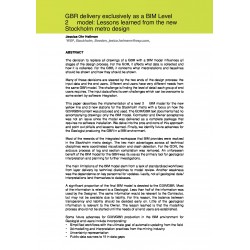Cart
0
0
No document
0,00 €
Total
Document successfully added to your shopping cart
Quantity
Total
There are 0 items in your cart.
There is 1 item in your cart.
Total documents
Total shipping
To be determined
Total
Search & filter
Search for a publication
Search & filter
GBR delivery exclusively as a BIM Level 2 ½ model: Lessons learned from the new Stockholm metro design
809_gbr_delivery_exclusively_as_
The decision to replace all drawings of a GBR with a BIM model influences all stages of the design process. For the GDR, it affects what data is collected and how it is collected. For the GBR, it concerns what interpretations and baselines should be shown and how they should be shown. Many of these decisions are steered by the two ends of the design process: the input data and the end users. Different end users have very different needs from the same GBR model. The challenge is finding the level of detail each group of end users requires. The input data offers its own challenges which can be overcome to some extent by software integration.This paper describes the implementation of a level 2 ½ BIM model for the new yellow line and 3 new stations for the Stockholm metro with a focus on how the GDR/GBR content was produced and used. The GDR/GBR text documents had no accompanying drawings: only the BIM model. Contractor and Owner acceptance was not an issue since the model was delivered as a complete package that requires no software installation. We delve into the pros and cons of this approach and point out pitfalls and lessons learned. Finally, we identify future advances for the Geologist producing the GBR in a BIM environment.Most of the rewards of the integrated workspace that BIM provides were realized in the Stockholm metro design. The two main advantages across all technical disciplines were coordinated visualization and clash detection. For the GDR, the arduous process of log and section compilation was removed. An unforeseen benefit of the BIM model for the GBR was its use as the primary tool for geological interpretation and planning for further investigations.The main limitations of the BIM model stem from a lack of standardized workflows: from layer delivery by technical disciplines to model review. Another weakness was the dependence on key personnel for updates. Lastly, not all geological data/interpretations lend themselves to databases. A significant proportion of the final BIM model is devoted to the GDR/GBR. Most of the information is relevant to a Geologist. Less than half of the information was used by the Designer. The same information would be relevant to the Contractor, but may not be available due to liability. For this reason, the balance between transparency and liability should be decided early on. Little of the geological information is relevant to the Owner.




